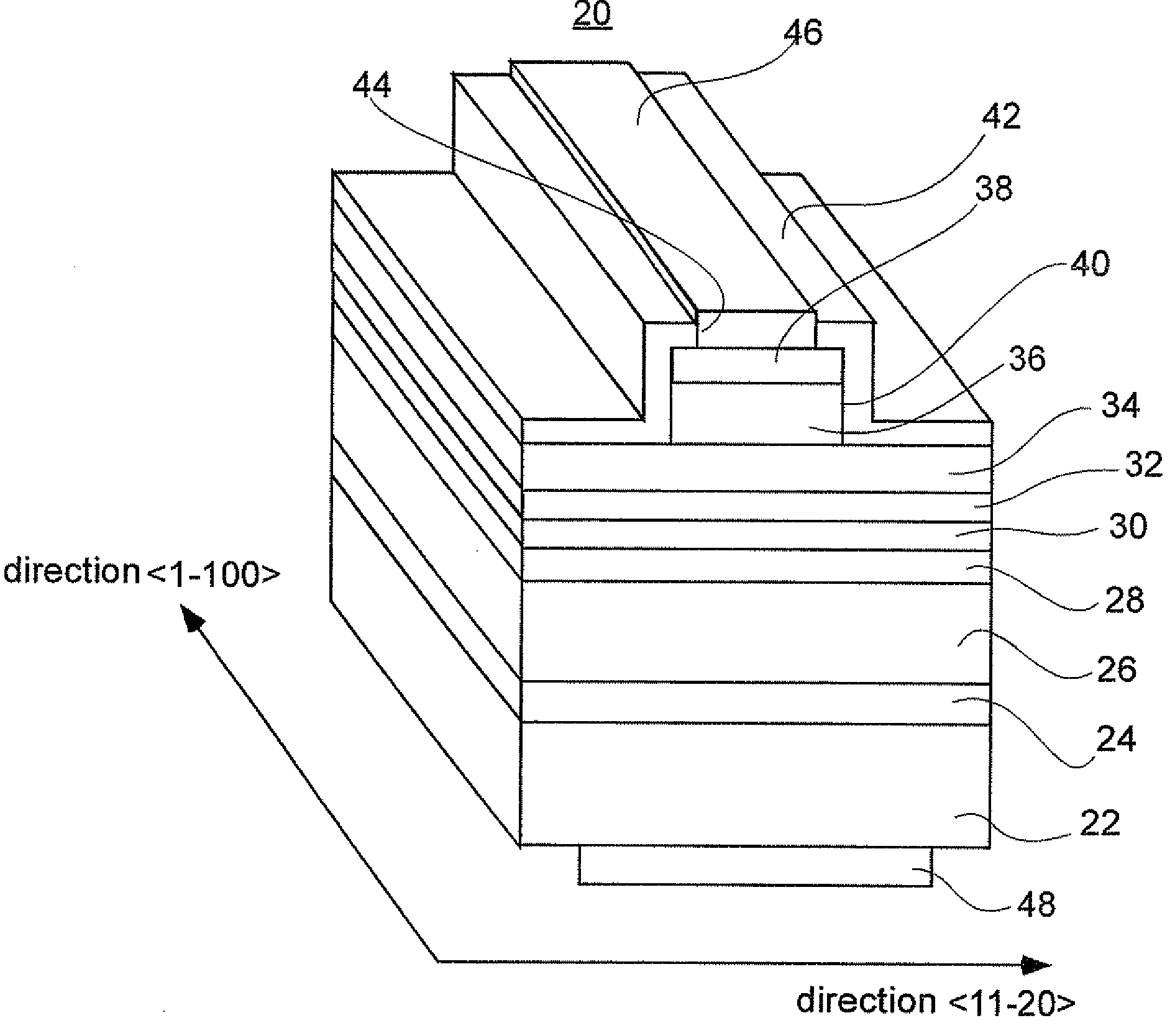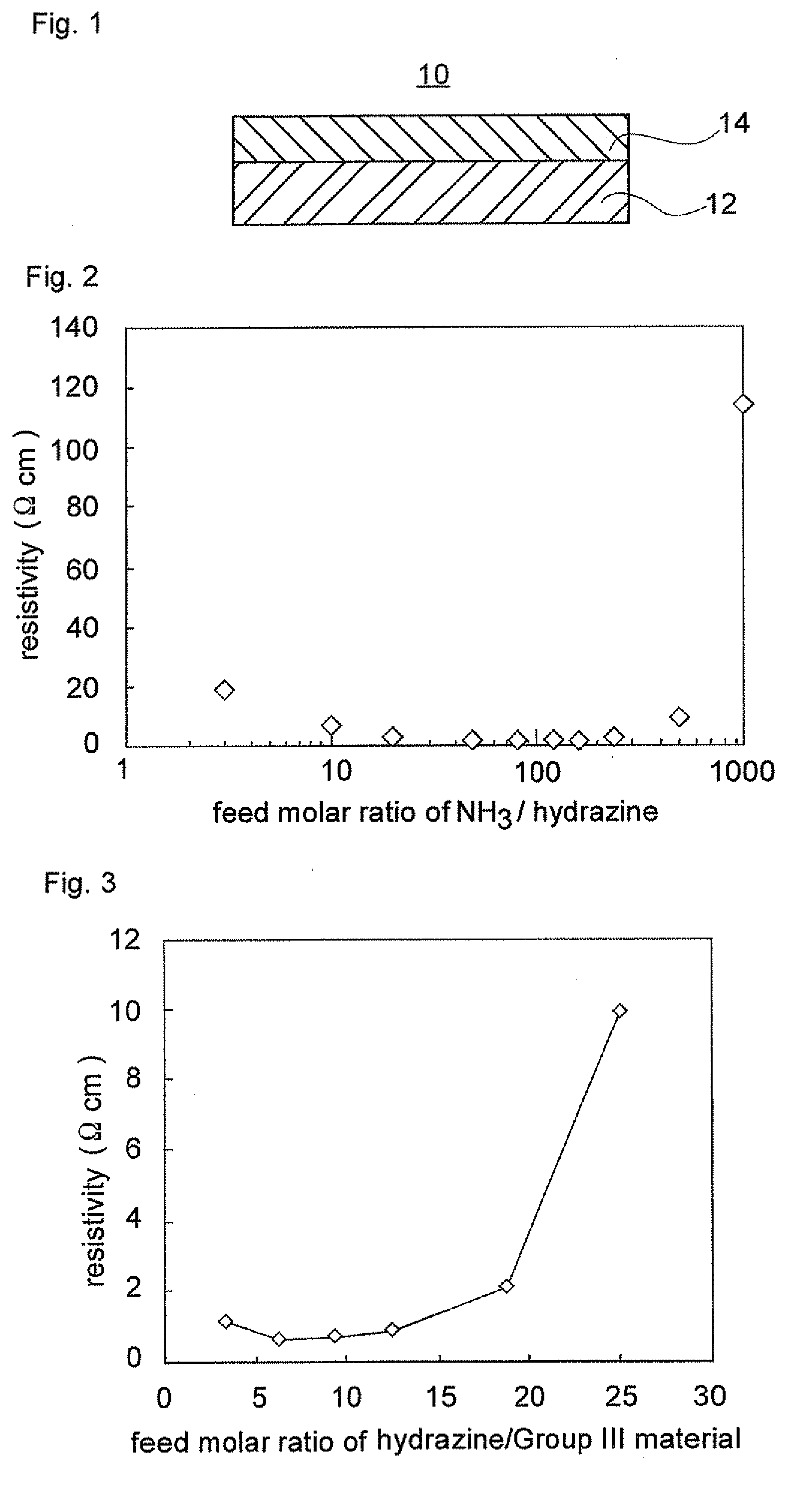Nitride semiconductor stacked structure and semiconductor optical device, and methods for manufacturing the same
a technology of stacked structure and semiconductor, which is applied in the direction of lasers, nanoinformatics, semiconductor lasers, etc., can solve the problems of (n) desorption, complex manufacturing process, and crystal degradation, and achieve the effect of low resistance, low resistance, and low resistan
- Summary
- Abstract
- Description
- Claims
- Application Information
AI Technical Summary
Benefits of technology
Problems solved by technology
Method used
Image
Examples
first embodiment
[0036]FIG. 1 is a schematic view showing a section of a GaN stacked structure according to one embodiment of the present invention. It will be noted that like reference numerals indicate corresponding or like members throughout the drawings.
[0037]In FIG. 1, a GaN stacked structure 10 constitutes, for example, part of a stacked structure of blue-violet LD.
[0038]A GaN substrate 12 serving as a substrate makes use of a (0001) face as a main surface and a p—GaN layer 14 serving as a p-type nitride semiconductor layer is disposed on this main surface.
[0039]The manufacturing procedure of the GaN stacked structure 10 is illustrated.
[0040]In general, the crystal growth for forming a nitride semiconductor stacked structure is carried out by a metal organic chemical vapor deposition (MOCVD) method, molecular beam epitaxy (MBE), hydride vapor phase epitaxy (HVPE) or the like. The MOCVD method is, for example, used herein.
[0041]Trimethylgallium (TMGa), which is an organometallic compound, is us...
modification 1
[0071]In the manufacturing steps set out hereinabove, the case where nitrogen (N2) gas alone is used as a carrier gas for starting gases has been illustrated, there may be used, as a carrier gas, a mixed gas of nitrogen (N2) gas and hydrogen (H2) gas, or hydrogen (H2) gas alone.
[0072]More particularly, when a compositional ratio by volume of hydrogen gas is taken as x and a compositional ratio by volume of nitrogen gas is taken as 1-x, the manufacture is feasible using a mixed gas of hydrogen gas and nitrogen gas within a range of 1=x=0.
[0073]For instance, where hydrogen gas and nitrogen gas are mixed at 1:1 to provide a mixed gas, the nitrogen gas is fed at a feed flow rate of 10 liters / minute and the hydrogen gas is fed at a feed flow rate of 10 liters / minute to provide a mixed gas.
[0074]Other manufacturing conditions are the same as those manufacturing conditions using nitrogen gas alone as a carrier gas.
[0075]It has been found that when the p—GaN layer of Modification 1 made by ...
second embodiment
[0097]FIG. 6 is a perspective view of LD according to one embodiment of the present invention.
[0098]In FIG. 6, LD 20 is a blue-violet LD having a ridge-type waveguide and includes a n—GaN substrate 22 used as a substrate. There are successively stacked, on a (0001) face serving as a main surface of the n—GaN substrate 22, a 1 μm thick buffer layer 24 made of n—GaN, a 1.0 μm thick cladding layer 26 formed of n—Al0.07Ga0.93N on the buffer layer a 0.1 μm thick n-side optical guide layer 28 made of n—GaN on the n-cladding layer and an active layer 30.
[0099]The active layer 30 has a multiple quantum well structure provided with three pairs of 3.5 μm thick well layers made of In0.12Ga0.88N and 7.0 nm thick barrier layers made of GaN, which are alternately stacked.
[0100]There are successively formed, over the active layer 30, a 0.2 μm thick p-type electron barrier layer 32 formed of p—Al0.07Ga0.93N and a 0.1 μm thick p-side optical guide layer 34 formed of p—GaN. Next, a 0.4 μm thick p-cla...
PUM
| Property | Measurement | Unit |
|---|---|---|
| temperature | aaaaa | aaaaa |
| temperature | aaaaa | aaaaa |
| temperature | aaaaa | aaaaa |
Abstract
Description
Claims
Application Information
 Login to View More
Login to View More - R&D
- Intellectual Property
- Life Sciences
- Materials
- Tech Scout
- Unparalleled Data Quality
- Higher Quality Content
- 60% Fewer Hallucinations
Browse by: Latest US Patents, China's latest patents, Technical Efficacy Thesaurus, Application Domain, Technology Topic, Popular Technical Reports.
© 2025 PatSnap. All rights reserved.Legal|Privacy policy|Modern Slavery Act Transparency Statement|Sitemap|About US| Contact US: help@patsnap.com



